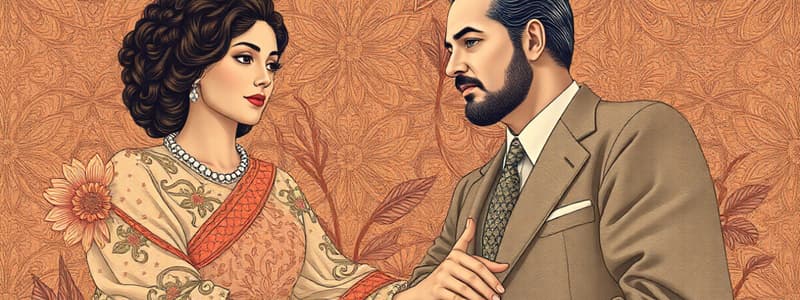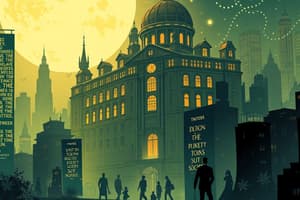Podcast
Questions and Answers
Who delivered the famous 'I Have a Dream' speech during the March on Washington?
Who delivered the famous 'I Have a Dream' speech during the March on Washington?
- A. Philip Randolph
- Roy Wilkins
- John Lewis
- Martin Luther King Jr. (correct)
What was one of the primary goals of the March on Washington?
What was one of the primary goals of the March on Washington?
- To protest the Vietnam War
- To ensure equal rights in public life (correct)
- To promote economic development in urban areas
- To advocate for women's suffrage
What criticism did Malcolm X voice regarding the March on Washington?
What criticism did Malcolm X voice regarding the March on Washington?
- It lacked adequate media coverage
- It failed to include all races
- It was too militant and aggressive
- It was too pacifist and non-confrontational (correct)
Which organization was primarily focused on legal battles against segregation and discrimination?
Which organization was primarily focused on legal battles against segregation and discrimination?
What significant historical site did the March on Washington symbolically trace to?
What significant historical site did the March on Washington symbolically trace to?
What was the primary focus of the Economic Opportunity Act of 1964?
What was the primary focus of the Economic Opportunity Act of 1964?
Which legislation prohibited discrimination based on sex, race, and religion in 1964?
Which legislation prohibited discrimination based on sex, race, and religion in 1964?
What did Betty Friedan's book, 'The Feminine Mystique,' primarily address?
What did Betty Friedan's book, 'The Feminine Mystique,' primarily address?
What was a significant societal challenge during President Johnson's Great Society?
What was a significant societal challenge during President Johnson's Great Society?
Which group did the National Organization for Women (NOW) primarily advocate for?
Which group did the National Organization for Women (NOW) primarily advocate for?
In what decade did the Second Wave of feminism primarily occur?
In what decade did the Second Wave of feminism primarily occur?
Which event marked a turning point leading to increased social tensions in the 1960s?
Which event marked a turning point leading to increased social tensions in the 1960s?
What was the main intention behind President Johnson's vision for the Great Society?
What was the main intention behind President Johnson's vision for the Great Society?
What was one of the key policies implemented under Reaganomics?
What was one of the key policies implemented under Reaganomics?
What was a notable criticism of Reaganomics?
What was a notable criticism of Reaganomics?
Which economic philosophy is closely associated with both Reagan and Thatcher?
Which economic philosophy is closely associated with both Reagan and Thatcher?
What legacy did Sandra Day O'Connor leave in American politics?
What legacy did Sandra Day O'Connor leave in American politics?
What did Pat Buchanan describe as a significant aspect of American society during the 1990s?
What did Pat Buchanan describe as a significant aspect of American society during the 1990s?
What economic challenge characterized the 1980s and contributed to a decline in American exceptionalism?
What economic challenge characterized the 1980s and contributed to a decline in American exceptionalism?
Which court case upheld significant changes in gender norms during the conservative backlash of the 1980s?
Which court case upheld significant changes in gender norms during the conservative backlash of the 1980s?
Which of the following was a key campaign focus of the Moral Majority during the conservative revival?
Which of the following was a key campaign focus of the Moral Majority during the conservative revival?
What was one of the main beliefs of neoconservatism that emerged in the 1960s-1970s?
What was one of the main beliefs of neoconservatism that emerged in the 1960s-1970s?
What characterized Ronald Reagan's approach to government during his 1980 presidential campaign?
What characterized Ronald Reagan's approach to government during his 1980 presidential campaign?
What policy did Reagan initiate that focused on missile defense systems during the Cold War?
What policy did Reagan initiate that focused on missile defense systems during the Cold War?
Who were the primary leaders of the New Right coalition during the conservative resurgence?
Who were the primary leaders of the New Right coalition during the conservative resurgence?
Which president is associated with the famous quote, 'Government is not the solution to our problem; government is the problem'?
Which president is associated with the famous quote, 'Government is not the solution to our problem; government is the problem'?
Flashcards
March on Washington
March on Washington
A massive demonstration in 1963, organized by A. Philip Randolph and led by Martin Luther King Jr., Roy Wilkins, and John Lewis, demanding civil rights legislation.
I Have a Dream Speech
I Have a Dream Speech
The iconic speech delivered by Martin Luther King Jr. at the March on Washington, advocating for racial equality and freedom.
NAACP
NAACP
The National Association for the Advancement of Colored People, founded in 1909, fighting legal battles against segregation and discrimination.
SNCC
SNCC
Signup and view all the flashcards
Impact of the 1960s
Impact of the 1960s
Signup and view all the flashcards
Great Society
Great Society
Signup and view all the flashcards
Medicare
Medicare
Signup and view all the flashcards
Medicaid
Medicaid
Signup and view all the flashcards
Civil Rights Act of 1964
Civil Rights Act of 1964
Signup and view all the flashcards
War on Poverty
War on Poverty
Signup and view all the flashcards
Second Wave Feminism
Second Wave Feminism
Signup and view all the flashcards
Betty Friedan - The Problem that Has No Name
Betty Friedan - The Problem that Has No Name
Signup and view all the flashcards
National Organization for Women (NOW)
National Organization for Women (NOW)
Signup and view all the flashcards
Reaganomics
Reaganomics
Signup and view all the flashcards
Neoliberalism
Neoliberalism
Signup and view all the flashcards
Social Conservatism
Social Conservatism
Signup and view all the flashcards
Culture Wars
Culture Wars
Signup and view all the flashcards
Pat Buchanan
Pat Buchanan
Signup and view all the flashcards
Stagflation
Stagflation
Signup and view all the flashcards
Moral Majority
Moral Majority
Signup and view all the flashcards
Evil Empire
Evil Empire
Signup and view all the flashcards
Deregulation
Deregulation
Signup and view all the flashcards
Neoconservatism
Neoconservatism
Signup and view all the flashcards
Strategic Defense Initiative (SDI)
Strategic Defense Initiative (SDI)
Signup and view all the flashcards
What were the key policies enacted by Ronald Reagan?
What were the key policies enacted by Ronald Reagan?
Signup and view all the flashcards
Study Notes
The Great Society
- Lyndon B. Johnson, elected in 1964, pursued a vision for a more abundant America.
- Sought to end discrimination based on race or gender, fostering equal rights.
- Key legislation included the Social Security Act of 1965, creating Medicare (elderly health insurance) and Medicaid (low-income health insurance).
- The Civil Rights Act of 1964 outlawed discrimination based on race, color, religion, sex, or national origin.
- The Economic Opportunity Act of 1964 formed the basis for the "War on Poverty".
- It established the Office of Economic Opportunity (OEO) to oversee programs addressing poverty through education, job training and community development.
- The "War on Poverty" built upon the New Deal's core principles (relief, recovery, and reform).
- Challenges and pushback arose from both the escalating Vietnam War and continued civil rights struggles.
The Women's Rights Movement (Second Wave Feminism)
- The 1960s and 70s witnessed the emergence of the Second Wave Feminism.
- This movement built on the First Wave's focus on suffrage (19th Amendment).
- Betty Friedan, a key figure, highlighted the dissatisfaction of women with their limited roles through "The Feminine Mystique" (1963).
- Friedan co-founded NOW (National Organization for Women) in 1966 to advance legal and workplace equality, reproductive rights and anti-discrimination policies.
- Drawing inspiration from Simone de Beauvoir's "The Second Sex".
The Student Movement
- Social tensions in the 1960s, including economic inequality and civil rights issues, fueled youth discontent.
- The Vietnam War further exacerbated these tensions.
- A distinct counterculture emerged, characterized by Rock 'n' Roll and a unique youth culture.
- The assassination of John F. Kennedy in 1963 caused widespread disillusionment.
The March on Washington (1963)
- Organized by A. Philip Randolph with key leaders like Martin Luther King Jr., Roy Wilkins, and John Lewis.
- The August 28, 1963 March aimed to push for the Civil Rights Act.
- The march advocated for an end to discrimination in employment, education, and public life.
- The march culminated in MLK's “I Have a Dream” speech.
- The march's impact was heightened by national TV coverage, symbolizing the fight for equality.
Civil Rights Organizations
- The NAACP (National Association for the Advancement of Colored People), founded in 1909, fought discrimination through legal action.
- The SNCC (Student Nonviolent Coordinating Committee), established in 1960, championed nonviolent resistance and community organizing, playing roles in sit-ins, freedom rides, and voter registration drives.
1960s Context
- The 1960s showcased both progress (civil rights legislation, Great Society reforms) and polarization (Vietnam War, cultural shifts).
- The decade's legacy continues to inspire social movements like LGBTQ+ rights and environmentalism.
- The decade demonstrated the potential of mass mobilization in shaping policy.
1980s Conservatism
- The 1980s saw a resurgence of conservatism in the US.
- Economic challenges like high inflation ("stagflation") and unemployment fuelled a desire for change.
- American exceptionalism declined due to international setbacks.
- A cultural divide arose with progressive trends in sexual liberation and evolving gender roles, met by a conservative backlash rooted in Christian conservatism and traditional values.
- Key Republican presidents included Ronald Reagan (1980, 1984), George H.W. Bush (1988), and George W. Bush (2000), marking a period of conservative dominance in the presidency, Senate, and House.
- Christian groups like the Moral Majority (1979-1989), led by Jerry Falwell, campaigned against abortion and the Equal Rights Amendment.
1980 Presidential Election
- Jimmy Carter faced criticism for his handling of the "Crisis of Confidence," the energy crisis, and rising inflation.
- Ronald Reagan capitalized on discontent and portrayed a strong leadership alternative that resonated with the resurgent conservative sentiment. His famous quote, "Government is not the solution to our problem; government is the problem," encapsulated this message.
- Reagan attacked Carter's record and advocated Reaganomics. He utilized conservative sentiment to present himself as a confident leader.
- Reagan's landslide victory marked the resurgence of conservatism in US politics.
Key Developments and Policies
- Business Lobbies and Think Tanks: Organisations like the Heritage Foundation and the National Association of Manufacturers played significant roles in shaping conservative policies.
- Neoconservatism: Emerged in the 1970s, fuelled by disillusionment with counter-culture movements and concern about societal decline from drug use, moral erosion, and challenges to family values. It advocated interventionist foreign policy in contrast to détente, and opposed leftist ideologies within education.
- New Right vs. New Left: The New Right, a conservative coalition of Christian leaders and business elites, advocated for traditional values, opposing social programs, and emphasizing religion in education and media (televangelists).
- Reagan's Policies: Reagan's administration implemented deregulation across public services, healthcare, and environmental protection, rolling back some New Deal and Fair Deal programs. His foreign policy characterized the Soviet Union as an 'Evil Empire' and supported confrontation during the Cold War. An emblematic initiative was the Strategic Defense Initiative (SDI). Reaganomics, a supply-side economic approach, featured significant tax cuts (favoring higher income brackets) to stimulate economic activity.
- Reaganomics Criticism: Its implementation led to a tripling of the national debt from $1 trillion to $3 trillion, while also increasing income inequality.
- Neoliberalism: Shared links with Reagan's policies and Margaret Thatcher's UK policies focused on privatization, tax cuts and deregulation.
- Sandra Day O'Connor: First woman appointed to the Supreme Court (1981), she held moderate Republican views and opposed overturning Roe v. Wade, advocating for women's rights. She later received the Presidential Medal of Freedom (2009), showcasing a progressive legacy for women in law and politics.
- Pat Buchanan and the 1990s "culture wars": A conservative commentator, he articulated concerns over cultural divisions, framing the 1992 election as a religious and cultural struggle.
Key Themes to Remember
- Economic: Reaganomics lessened inflation but widened income disparity and increased national debt.
- Cultural: Neoconservatism and the New Right confronted counter-culture movements.
- Political: Conservatism dominated the political landscape through Republican leadership and policies, including deregulation and tax cuts.
- Social: Fierce ideological clashes emerged regarding morality, religion, and national identity.
Studying That Suits You
Use AI to generate personalized quizzes and flashcards to suit your learning preferences.
Description
Explore the key initiatives and legislation of Lyndon B. Johnson's Great Society, aimed at promoting equality and fighting poverty in America. Additionally, delve into the Second Wave Feminism that emerged during the 1960s and 70s, highlighting the struggle for women's rights. This quiz covers vital historical movements that shaped modern America.




